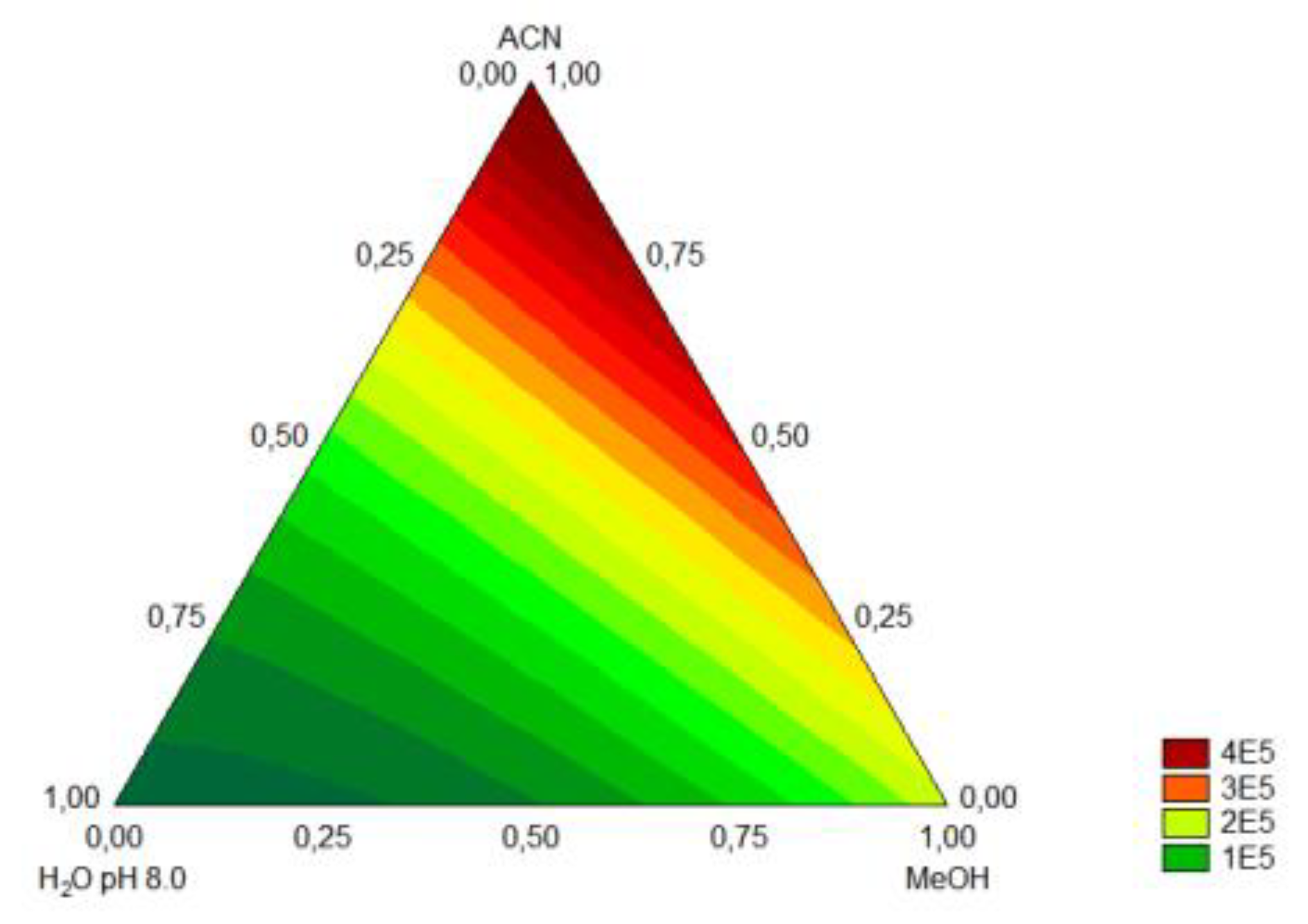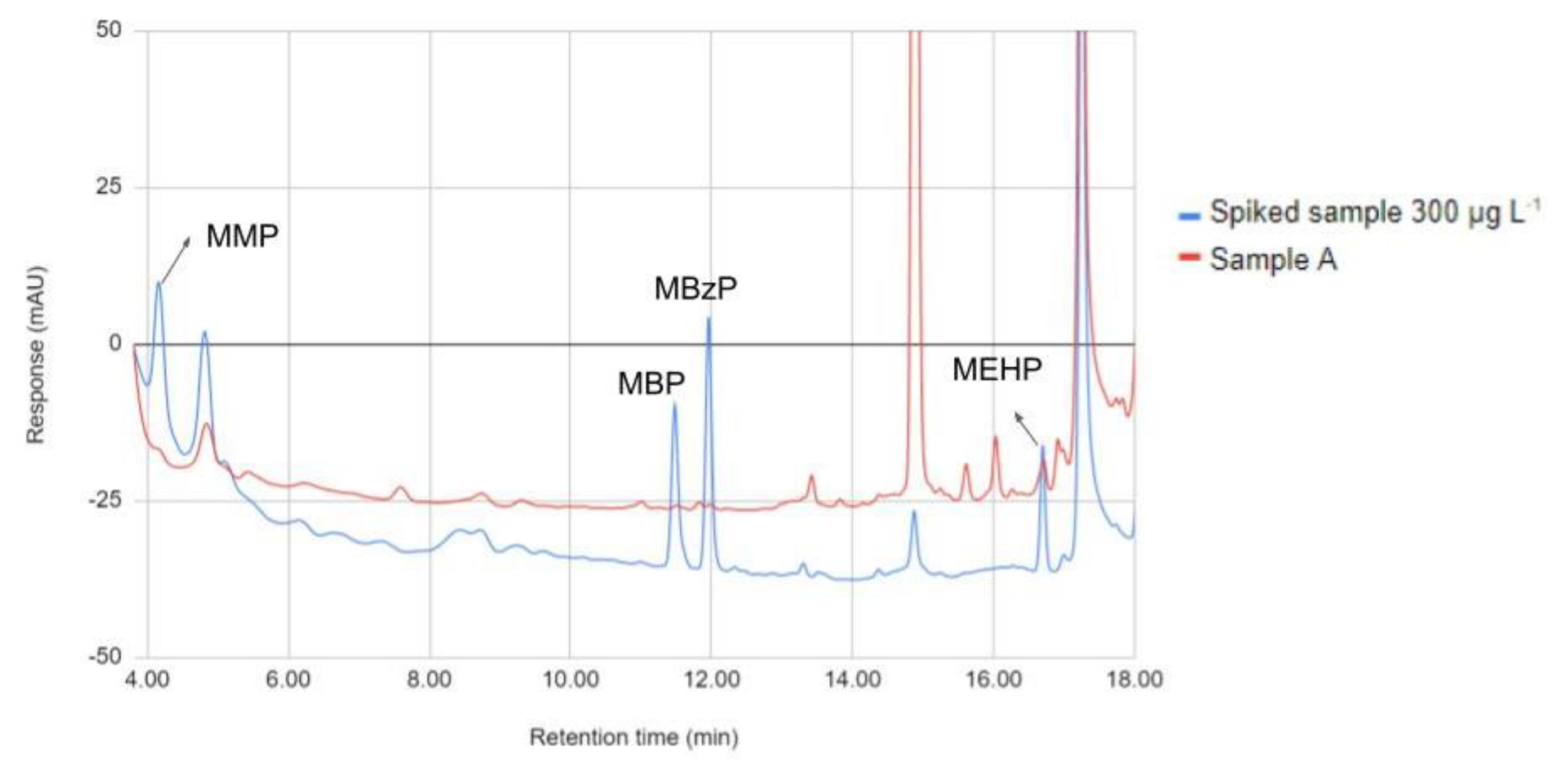Disposable Pipette Extraction (DPX) Coupled to HPLC-DAD as an Alternative for the Determination of Phthalic Monoesters in Urine Samples
Abstract
1. Introduction
2. Materials and Methods
2.1. Reagents and Samples
2.2. Instrumentation
2.3. Sample Preparation Procedure
2.4. Optimization of DPX Procedure
2.5. Determination of Analytical Parameters of Merit and Method Application
3. Results and Discussion
3.1. Method Optimization
3.1.1. Evaluation of the Washing Step
3.1.2. Selection of Desorption Solvent
3.1.3. Number of Desorption Cycles and Volume
3.1.4. Number of Desorption Cycles and Volume
3.1.5. Adjustment of Sample pH
3.1.6. Evaluation of the Clean-Up Step
3.1.7. Evaluation of Sample Dilution
3.2. Analytical Parameters of Merit
3.3. Application of the Method
3.4. Comparison with Other Methods from the Literature
4. Conclusions
Supplementary Materials
Author Contributions
Funding
Conflicts of Interest
References
- Mínguez-Alarcón, L.; Bellavia, A.; Gaskins, A.J.; Chavarro, J.E.; Ford, J.B.; Souter, I.; Calafat, A.M.; Hauser, R.; Williams, P.L. Paternal mixtures of urinary concentrations of phthalate metabolites, bisphenol A and parabens in relation to pregnancy outcomes among couples attending a fertility center. Environ. Int. 2021, 146, 106171. [Google Scholar] [CrossRef]
- Martínez, M.A.; Rovira, J.; Sharma, R.P.; Schuhmacher, M.; Kumar, V. Reconstruction of phthalate exposure and DINCH metabolites from biomonitoring data from the EXHES cohort of Tarragona, Spain: A case study on estimated vs reconstructed DEHP using the PBPK model. Environ. Res. 2020, 186, 109534. [Google Scholar] [CrossRef]
- Wang, Y.; Zhu, H.; Kannan, K. A Review of Biomonitoring of Phthalate Exposures. Toxics 2019, 7, 21. [Google Scholar] [CrossRef]
- Latini, G. Monitoring phthalate exposure in humans. Clin. Chim. Acta 2005, 361, 20–29. [Google Scholar] [CrossRef] [PubMed]
- Mok, S.; Jeong, Y.; Park, M.; Kim, S.; Lee, I.; Park, J.; Kim, S.; Choi, K.; Moon, H.B. Exposure to phthalates and bisphenol analogues among childbearing-aged women in Korea: Influencing factors and potential health risks. Chemosphere 2021, 264, 128425. [Google Scholar] [CrossRef]
- Huelsmann, R.D.; Will, C.; Carasek, E. Novel strategy for disposable pipette extraction (DPX): Low-cost Parallel-DPX for determination of phthalate migration from common plastic materials to saliva simulant with GC-MS. Talanta 2021, 221, 121443. [Google Scholar] [CrossRef] [PubMed]
- Mankidy, R.; Wiseman, S.; Ma, H.; Giesy, J.P. Biological impact of phthalates. Toxicol. Lett. 2013, 217, 50–58. [Google Scholar] [CrossRef] [PubMed]
- Tsochatzis, E.D.; Tzimou-Tsitouridou, R.; Gika, H.G. Analytical Methodologies for the Assessment of Phthalate Exposure in Humans. Crit. Rev. Anal. Chem. 2017, 57, 279–297. [Google Scholar] [CrossRef] [PubMed]
- Souza-Silva, E.A.; Reyes-Garcés, N.; Gómez-Ríos, G.A.; Boyacı, E.; Bojko, B.; Pawliszyn, J. A critical review of the state of the art of solid-phase microextraction of complex matrices III. Bioanalytical and clinical applications. TrAC Trends Anal. Chem. 2015, 71, 249–264. [Google Scholar] [CrossRef]
- Mafra, G.; Spudeit, D.; Brognoli, R.; Merib, J.; Carasek, E. Expanding the applicability of cork as extraction phase for disposable pipette extraction in multiresidue analysis of pharmaceuticals in urine samples. J. Chromatogr. B 2018, 1102–1103, 159–166. [Google Scholar] [CrossRef]
- Carasek, E.; Morés, L.; Merib, J. Basic principles, recent trends and future directions of microextraction techniques for the analysis of aqueous environmental samples. Trends Environ. Anal. Chem. 2018, 19, e00060. [Google Scholar] [CrossRef]
- Carasek, E.; Merib, J. Membrane-based microextraction techniques in analytical chemistry: A review. Anal. Chim. Acta 2015, 880, 8–25. [Google Scholar] [CrossRef] [PubMed]
- Maciel, E.V.S.; de Toffoli, A.L.; Neto, E.S.; Nazario, C.E.D.; Lanças, F.M. New materials in sample preparation: Recent advances and future trends. TrAC Trends Anal. Chem. 2019, 119, 115633. [Google Scholar] [CrossRef]
- Arthur, C.L.; Pawliszyn, P. Solid phase microextraction with thermal desorption using fused silica optical fibers. Anal. Chem. 1990, 62, 2145–2148. [Google Scholar] [CrossRef]
- Jeong, S.H.; Jang, J.H.; Cho, H.Y.; Lee, Y.B. Toxicokinetics of diisobutyl phthalate and its major metabolite, monoisobutyl phthalate, in rats: UPLC-ESIMS/MS method development for the simultaneous determination of diisobutyl phthalate and its major metabolite, monoisobutyl phthalate, in rat plasma, urine, feces, and 11 various tissues collected from a toxicokinetic study. Food Chem. Toxicol. 2020, 145, 111747. [Google Scholar]
- Rastkari, N.; Ahmadkhaniha, R. Magnetic solid-phase extraction based on magnetic multi-walled carbon nanotubes for the determination of phthalate monoesters in urine samples. J. Chromatogr. A 2013, 1286, 22–28. [Google Scholar] [CrossRef]
- Sun, J.N.; Shi, Y.P.; Chen, J. Simultaneous determination of plasticizer di(2-ethylhexyl)phthalate and its metabolite in human urine by temperature controlled ionic liquid dispersive liquid–liquid microextraction combined with high performance liquid chromatography. Anal. Methods 2013, 5, 1427–1434. [Google Scholar] [CrossRef]
- Wu, J.; Ye, Z.; Li, X.; Wang, X.; Luo, F.; Sheng, B.; Li, Y.; Lyu, J. Optimization of a NH4PF6-enhanced, non-organic solvent, dual microextraction method for determination of phthalate metabolites in urine by high performance liquid chromatography. J. Chromatogr. B 2016, 1014, 1–9. [Google Scholar] [CrossRef] [PubMed]
- Fernandez, M.A.M.; André, L.C.; de LourdesCardeal, Z. Hollow fiber liquid-phase microextraction-gas chromatography-mass spectrometry method to analyze bisphenol A and other plasticizer metabolites. J. Chromatogr. A 2017, 1481, 31–36. [Google Scholar] [CrossRef] [PubMed]
- Elliani, R.; Naccarato, A.; Malacaria, L.; Tagarelli, A. A rapid method for the quantification of urinary phthalate monoesters: A new strategy for the assessment of the exposure to phthalate ester by solid-phase microextraction with gas chromatography and tandem mass spectrometry. J. Sep. Sci. 2020, 43, 3061–3073. [Google Scholar] [CrossRef]
- Alzaga, R.; Peña, A.; Bayona, J.M. Determination of phthalic monoesters in aqueous and urine samples by solid-phase microextraction–diazomethane on-fibre derivatization–gas chromatography–mass spectrometry. J. Sep. Sci. 2003, 26, 87–96. [Google Scholar] [CrossRef]
- Servaes, K.; Voorspoels, S.; Lievens, J.; Noten, B.; Allaerts, K.; Van De Weghe, H.; Vanermen, G. Direct analysis of phthalate ester biomarkers in urine without preconcentration: Method validation and monitoring. J. Chromatogr. A 2013, 1294, 25–32. [Google Scholar] [CrossRef] [PubMed]
- Brewer, W.E. Disposable Pipette Extraction. U.S. Patent 6566145B2, 20 May 2003. [Google Scholar]
- Bordin, D.C.M.; Alves, M.N.R.; de Campos, E.G.; Martinis, B.S.D. Disposable pipette tips extraction: Fundamentals, applications and state of the art. J. Sep. Sci. 2016, 39, 1168–1172. [Google Scholar] [CrossRef] [PubMed]
- Corazza, G.; Merib, J.; Magosso, H.A.; Bittencourt, O.O.; Carasek, E. A hybrid material as a sorbent phase for the disposable pipette extraction technique enhances efficiency in the determination of phenolic endocrine-disrupting compounds. J. Chromatogr. A 2017, 1513, 42–50. [Google Scholar] [CrossRef]
- Corazza, G.; Merib, J.; do Carmo, S.N.; Mendes, L.D.; Carasek, E. Assessment of a Fully Optimized DPX-Based Procedure for the Multiclass Determination of Pesticides in Drinking Water Using High-Performance Liquid Chromatography with Diode Array Detection. J. Braz. Chem. Soc. 2019, 30, 1211–1221. [Google Scholar] [CrossRef]
- Merib, J.; Spudeit, D.A.; Corazza, G.; Carasek, E.; Anderson, J.L. Magnetic ionic liquids as versatile extraction phases for the rapid determination of estrogens in human urine by dispersive liquid-liquid microextraction coupled with high performance liquid chromatography-diode array detection. Anal. Bioanal. Chem. 2018, 410, 4689–4699. [Google Scholar] [CrossRef]
- Rambla-Alegre, M.; Esteve-Romero, J.; Carda-Broch, S. Is it really necessary to validate an analytical method or not? That is the question. J. Chromatogr. A 2012, 1232, 101–109. [Google Scholar] [CrossRef]
- Leonardi, F.; Veschetti, M.; Tonnarini, S.; Cardellini, F.; Trevisi, R. A step towards accreditation: A robustness test of etching process. Appl. Radiat. Isot. 2015, 102, 93–97. [Google Scholar] [CrossRef]
- Karageorgou, E.; Samanidou, V. Youden test application in robustness assays during method validation. J. Chromatogr. A 2014, 1353, 131–139. [Google Scholar] [CrossRef]
- Sargazi, S.; Mirzaei, R.; Rahmani, M.; Mohammadi, M.; Khammari, A.; Sheikh, M. One-step in-syringe dispersive liquid–liquid microextraction and GC-FID determination of trace amounts of di(2-ethylhexyl) phthalate and its metabolite in human urine samples. J. Anal. Chem. 2017, 72, 557–561. [Google Scholar] [CrossRef]
- Ye, Z.; Ma, M.; Guo, Y.; Zong, M.; Ding, M.; Fan, L. Determination of Phthalate and Metabolites in Human Urine by Lithium Bis(trifluoromethanesulfonyl)imide-Enhanced Dual Microextraction Method Optimized by Central Composite Design. Chromatographia 2020, 83, 397–408. [Google Scholar] [CrossRef]




| Analyte | LOD (μg L−1) | LOQ (μg L−1) | Linear Range (μg L−1) | R2 | Linear Equation |
|---|---|---|---|---|---|
| MMP | 7.6 | 25 | 25–300 | 0.9832 | y = 630.5x − 509.6 |
| MBP | 7.6 | 25 | 25–300 | 0.9980 | y = 557.6x + 1331.7 |
| MBzP | 3.0 | 10 | 10–300 | 0.9989 | y = 800.3x − 143.0 |
| MEHP | 7.6 | 25 | 25–300 | 0.9919 | y = 330.7x − 1173.3 |
| Analyte | Spiked Concentration (μg L−1) | Relative Recovery (%) | Precision (%RSD) | ||
|---|---|---|---|---|---|
| Sample A | Sample B | Intraday (n = 3) | Interday (n = 9) | ||
| MMP | 25 | 95 | 90 | 9.4 | |
| 150 | 83 | 94 | 9.2 | 15.6 | |
| 300 | 92 | 102 | 3.5 | ||
| MBP | 25 | 104 | 106 | 4.8 | |
| 150 | 102 | 118 | 10.5 | 11.2 | |
| 300 | 102 | 109 | 8.8 | ||
| MBzP | 25 | 104 | 105 | 0.3 | |
| 150 | 98 | 116 | 7.0 | 10.4 | |
| 300 | 98 | 108 | 9.0 | ||
| MEHP | 25 | 98 | 119 | 13.6 | |
| 150 | 98 | 120 | 10.1 | 9.9 | |
| 300 | 108 | 110 | 10.8 | ||
| Sample | Age | MMP | MBP | MBzP | MEHP |
|---|---|---|---|---|---|
| A | 23 | ND | ND | ND | <LOQ |
| B | 56 | ND | ND | ND | ND |
| C | 56 | ND | ND | ND | ND |
| D | 23 | ND | ND | ND | ND |
| Analytes | Sample Preparation Techniques | Instrumentation | Urine Volume (mL) | Linear Range (μg L−1) | Total Time of Methodology | Ref. |
|---|---|---|---|---|---|---|
| MMP, MBP, MBzP and MEHP | DPX | HPLC-DAD | 0.49 | 10–300 and 25–300 | >25 min | This work |
| MEHP | TC-IL-DLLME | HPLC-DAD | 20–1920 | >50 min | [17] | |
| MBzP and MEHP | ANSDM | HPLC-DAD | 1 | 2.0–1000 | >30.7 min | [18] |
| MEHP | In-syringe DLLME | GC-FID | 1 | 20–3000 | >30 min | [31] |
| MMP, MBP, MBzP and MEHP | HF-LPME | GC-MS | 16 | 20–100, 20–500, 10–200 and 20–1000 | 3.2 h | [19] |
| MBzP and MEHP | IL-DLLME | HPLC-DAD | 1 | 2–500 | >1 h | [32] |
| MBP and MEHP | SPME | GC-MS/MS | 0.5 | 1–250 and 5–250 | >4 h | [20] |
| MMP, MBP, MBzP and MEHP | MSPE | GC-MS | 2.0 | 0.25–250 | >3 h | [16] |
Publisher’s Note: MDPI stays neutral with regard to jurisdictional claims in published maps and institutional affiliations. |
© 2022 by the authors. Licensee MDPI, Basel, Switzerland. This article is an open access article distributed under the terms and conditions of the Creative Commons Attribution (CC BY) license (https://creativecommons.org/licenses/by/4.0/).
Share and Cite
Comelli, H.; Will, C.; Morés, L.; Bernardi, G.; Carasek, E. Disposable Pipette Extraction (DPX) Coupled to HPLC-DAD as an Alternative for the Determination of Phthalic Monoesters in Urine Samples. Separations 2022, 9, 294. https://doi.org/10.3390/separations9100294
Comelli H, Will C, Morés L, Bernardi G, Carasek E. Disposable Pipette Extraction (DPX) Coupled to HPLC-DAD as an Alternative for the Determination of Phthalic Monoesters in Urine Samples. Separations. 2022; 9(10):294. https://doi.org/10.3390/separations9100294
Chicago/Turabian StyleComelli, Heloisa, Camila Will, Lucas Morés, Gabrieli Bernardi, and Eduardo Carasek. 2022. "Disposable Pipette Extraction (DPX) Coupled to HPLC-DAD as an Alternative for the Determination of Phthalic Monoesters in Urine Samples" Separations 9, no. 10: 294. https://doi.org/10.3390/separations9100294
APA StyleComelli, H., Will, C., Morés, L., Bernardi, G., & Carasek, E. (2022). Disposable Pipette Extraction (DPX) Coupled to HPLC-DAD as an Alternative for the Determination of Phthalic Monoesters in Urine Samples. Separations, 9(10), 294. https://doi.org/10.3390/separations9100294








